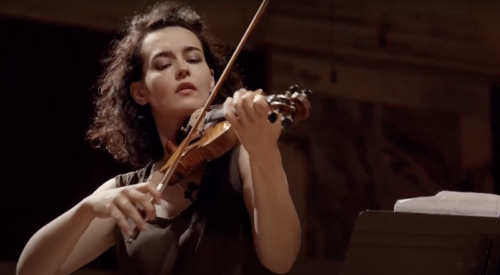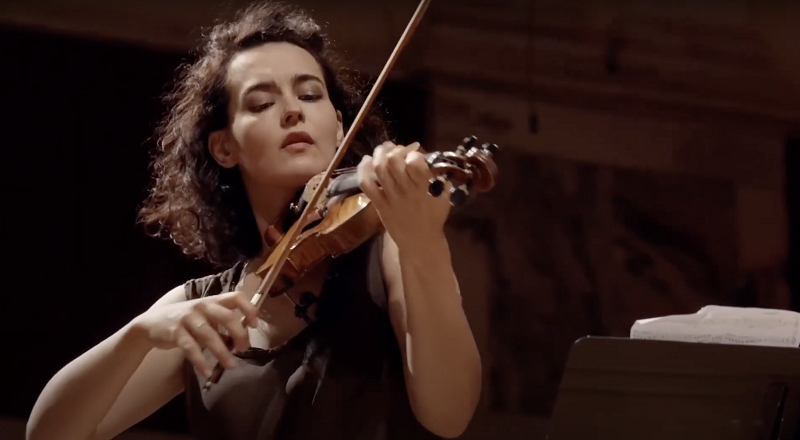 Switzerland Bernstein, Barber, Elgar: Alena Baeva (violin), Tonhalle Orchestra Zurich / Paavo Järvi (conductor). Tonhalle, Zurich, 11.11.2021. (JR)
Switzerland Bernstein, Barber, Elgar: Alena Baeva (violin), Tonhalle Orchestra Zurich / Paavo Järvi (conductor). Tonhalle, Zurich, 11.11.2021. (JR)

Bernstein – Divertimento for Orchestra
Barber –Violin concerto Op.14
Elgar – Enigma Variations Op.36
On the 11th day of November 1918 the Armistice was signed ending the First World War. On the 11th day of November at eleven minutes past 11 every year, COVID permitting, Carnival (‘Fasnacht’) officially starts in German-speaking principally Catholic parts of Europe. (Karneval then takes a long break until the real festivities in February). So what better pieces of music to perform on this November day, with those events in mind, than some jazzy Bernstein and ‘Nimrod’?
Paavo Järvi and the Tonhalle Orchestra were supposed to be in Japan on tour but the pandemic put paid to that, so we in Zurich are fortunate to enjoy some extra concerts on home turf. This concert gave Järvi the chance to introduce some American and British works which would not be all that familiar to a (mainly) Swiss audience.
Bernstein was an important source of inspiration for Paavo Järvi. Järvi studied with Bernstein at the Curtis Institute from 1980 when he left Estonia for the USA. (Samuel Barber also studied at the Curtis.) The Divertimento for Orchestra, composed in 1980, is a set of eight miniatures, mostly only one or two minutes long, making a fifteen-minute suite rich in wit and variety. The Boston Symphony Orchestra had invited Bernstein to write a piece in honour of the orchestra’s centennial.
The first movement, called Sennets and Tuckets, (Shakespeare used those terms denoting fanfares) sets the scene; Bernstein’s easy-going style is instantly recognisable. This is followed by an off-kilter Waltz, for strings alone, and Rafael Rosenfeld (cello), Gilad Karni (viola) and Andreas Janke (violin) all made notable contributions. The Mazurka employs double-reed woodwinds and the harp, and finally solo oboe (another fine intervention from Simon Fuchs). Then a Samba with plenty of colourful percussion; here I wished I was hearing the Simon Bolivar Youth Orchestra under a young Gustavo Dudamel – the members of the Tonhalle did not have quite enough hair to let down. The Turkey Trot is great fun, strangely not heard that much, even as an encore. Sphinxes is gloomy and doesn’t seem to fit: it is the shortest movement, less than a minute long, and suggesting a twelve-tone row, leading straight into Blues scored for brass and percussion. David Bruchez-Lalli stood out with his trombone solo. The concluding movement, In Memoriam; March: ‘The BSO Forever’, starts solemnly, but then the tempo quickens. The two piccolos stood for their interjection, as did the entire brass section, to bring the work to its rousing conclusion. Järvi clearly enjoyed the piece; he did not dance on the podium as Bernstein would have done, but as usual was full of energy.
Barber, perhaps best known for his heart-rending Adagio for Strings, wrote the first movements of his only violin concerto while travelling in Europe, including Switzerland. The opening is utterly ravishing, full of melody. Alena Baeva, the young Russian violinist, immediately impressed with her tone (helped by her instrument, the ‘ex-William Kroll’ Guarneri del Gesù of 1738, on loan). I had not heard Baeva before and can see why Järvi (among others) is a keen champion of her skills and musicianship – we shall certainly see and hear a lot more of this excellent young artist.
The lush Andante gave the oboe a prominent role, with Fuchs once again impressing. The Finale doesn’t fit with the opening two movements, the soloist plays fast and furious and in a much more modernist style – a chance to admire Baeva’s fingerwork, which left nothing to be desired. The piece was very well received, and Baeva had made her mark with great aplomb.
An Englishman’s heart, especially on foreign soil, warms to the sound of Elgar and especially his Enigma Variations. I do not believe I need tell the history of its composition to an English-speaking readership, except that Elgar played a tune (very loosely derived from Mozart’s Prague Symphony, which he had just heard in Leeds) on the piano to his wife and then developed it into fourteen variations, attributing each to relatives and friends (and the last one to himself). At the age of 42, the work sealed his fame. There is much conjecture about what the enigma itself might be. I will not spill more ink over that but recommend you Google it.
I also will not describe every variation, suffice to say that the orchestra played it as to the manner born. The work is known to most players in the orchestra, having performed it under both David Zinman and Lionel Bringuier. The strings showed real depth in the 5th variation, the viola section shone in the 6th. Benjamin Forster (timpani) excelled, with the trombone section, in the 7th. ‘Nimrod’ brought a tear to the eye, just as it should; the full bloom and nobility of the orchestra was unleashed. (Järvi, already a London resident, instantly became an honorary Brit.) In Variation 12 it was Rafael Rosenfeld once again stealing the limelight; in variation 13 it was again the timpanist with the hard end of his sticks effecting the drum roll, whilst Mike Reid (clarinet) wooed us tenderly with his solo.
The mighty new organ of the Tonhalle joined the full force of the orchestra to great effect in the final variation (dedicated to Elgar himself), to end the masterpiece in a blaze of orchestral colour. The Swiss audience were utterly enthralled.
John Rhodes
